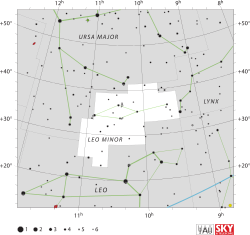20 Leonis Minoris, som är stjärnans Flamsteed-beteckning, är en dubbelstjärna, belägen i den mellersta delen av stjärnbilden Lilla lejonet. Den har en kombinerad skenbar magnitud av ca 5,40[2] och är svagt synlig för blotta ögat där ljusföroreningar ej förekommer. Baserat på parallaxmätning inom Hipparcosuppdraget på ca 66,5[1] mas, beräknas den befinna sig på ett avstånd på ca 49 ljusår (ca 15 parsek) från solen. Den rör sig bort från solen med en heliocentrisk radialhastighet på ca 56 km/s.[5] Den har en relativt stor egenrörelse och hade sin närmaste position till solen för 150 000 år sedan då den befann sig på ett avstånd av 32,2 ljusår,[13]
Snabbfakta Observationsdata Epok: J2000.0, Stjärnbild ...
| 20 Leonis Minoris |
 |
Observationsdata
Epok: J2000.0 |
|---|
| Stjärnbild | Lilla lejonet |
|---|
| Rektascension | 10t 01m 00,65765s[1] |
|---|
| Deklination | +31° 55′ 25,2151″[1] |
|---|
Skenbar magnitud ( ) ) | +5,40 (V)[2] |
|---|
| Stjärntyp |
|---|
| Spektraltyp | G3 Va Hδ1[3] + M7 V[4] |
|---|
| U–B | +0,27[5] |
|---|
| B–V | +0,64[5] |
|---|
| Astrometri |
|---|
Radialhastighet ( ) ) | +55,96 ± 0,09[6] km/s |
|---|
| Egenrörelse (µ) | RA: -527,63 ± 0,30[1] mas/år
Dek.: -429,42 ± 0,18[1] mas/år |
|---|
Parallax ( ) ) | 66,46 ± 0,32[1] |
|---|
| Avstånd | 49,1 ± 0,2 lå (15,05 ± 0,07 pc) |
|---|
Absolut magnitud ( ) ) | 4,46[7] |
|---|
| Detaljer |
|---|
| Massa | 1,12[8] / 0,11[8] M☉ |
|---|
| Radie | 1,247 ± 0,021[9] R☉ |
|---|
| Luminositet | 1,378 ± 0,027[9] L☉ |
|---|
| Temperatur | 5 735 ± 5,6[10] K |
|---|
| Ålder | 6,2 - 7,7[11] miljarder år |
|---|
| Andra beteckningar |
|---|
| 20 Lmi, LHS 2216, AG+32 990, BD+32 1964, CCDM J10010+3155A, FK5 1258, GJ 376 GJ 376 A, HD 86728, HIC 49081, HIP 49081, HR 3951, IRAS 09581+3209, LSPM J1001+3155, 2MASS J10010072+3155262, NLTT 23166, PLX 2366, PPM 74920, SAO 61808, TD1 14478, TYC 2503-1516-1, USNO-B1.0 1219-00195929, uvby98 100086728, WDS J10010+3155A, WISEA J100100.21+315520.6, Gaia DR2 746545172372256384 [12] |
Stäng
Primärstjärnan 20 Leonis Minoris A är en gul till vit stjärna i huvudserien av spektralklass G3 Va Hδ1.[3] Den har en massa som är ca 1,1[8] solmassor, en radie som är ca 1,25[9] solradier och utsänder från dess fotosfär ca 1,4[9] gånger mera energi än solen vid en effektiv temperatur av ca 5 700[10] K.
Den lilla följeslagaren 20 Leonis Minoris A är en aktiv röd stjärna av spektralklass M7 V,[4] som har en relativt hög metallicitet.[14] De två stjärnorna är för närvarande (2019) separerade med 14,5 bågsekunder, vilket motsvarar en projicerad separation av 2 016 AE.[8]
- Den här artikeln är helt eller delvis baserad på material från engelskspråkiga Wikipedia, 20 Leonis Minoris, 22 april 2020.
Noter
van Leeuwen, F. (November 2007), "Validation of the new Hipparcos reduction", Astronomy and Astrophysics, 474 (2): 653–664, arXiv:0708.1752, Bibcode:2007A&A...474..653V, doi:10.1051/0004-6361:20078357, hämtad 2009-12-18.
Hempelmann, A.; et al. (February 2016), "Measuring rotation periods of solar-like stars using TIGRE. A study of periodic CaII H+K S-index variability", Astronomy & Astrophysics, 586: 19, Bibcode:2016A&A...586A..14H, doi:10.1051/0004-6361/201526972, A14.
Keenan, P.; McNeil, R. (October 1989), "The Perkins catalog of revised MK types for the cooler stars", Astrophysical Journal Supplement Series, 71: 245–266, Bibcode:1989ApJS...71..245K, doi:10.1086/191373.
West, Andrew A.; et al. (October 2015), "An Activity-Rotation Relationship and Kinematic Analysis of Nearby Mid-to-Late-Type M Dwarfs", The Astrophysical Journal, 812 (1): 12, arXiv:1509.01590, Bibcode:2015ApJ...812....3W, doi:10.1088/0004-637X/812/1/3, 3.
Mermilliod, J.-C. (1986). "Compilation of Eggen's UBV data, transformed to UBV (unpublished)". Catalogue of Eggen's UBV Data. Bibcode:1986EgUBV........0M.
Gontcharov, G. A. (2006). "Pulkovo Compilation of Radial Velocities for 35 495 Hipparcos stars in a common system". Astronomy Letters. 32 (11): 759–771. arXiv:1606.08053. Bibcode:2006AstL...32..759G. doi:10.1134/S1063773706110065.
Holmberg, J.; et al. (July 2009), "The Geneva-Copenhagen survey of the solar neighbourhood. III. Improved distances, ages, and kinematics", Astronomy and Astrophysics, 501 (3): 941–947, arXiv:0811.3982, Bibcode:2009A&A...501..941H, doi:10.1051/0004-6361/200811191.
Tokovinin, A.; Kiyaeva, O. (February 2016), "Eccentricity distribution of wide binaries", Monthly Notices of the Royal Astronomical Society, 456 (2): 2070−2079, arXiv:1512.00278, Bibcode:2016MNRAS.456.2070T, doi:10.1093/mnras/stv2825.
Boyajian, Tabetha S.; et al. (February 2012), "Stellar Diameters and Temperatures. I. Main-sequence A, F, and G Stars", The Astrophysical Journal, 746 (1): 101, arXiv:1112.3316, Bibcode:2012ApJ...746..101B, doi:10.1088/0004-637X/746/1/101. See Table 10.
Kovtyukh; Soubiran, C.; Belik, S. I.; Gorlova, N. I. (2003), "High precision effective temperatures for 181 F-K dwarfs from line-depth ratios", Astronomy and Astrophysics, 411 (3): 559–564, arXiv:astro-ph/0308429, Bibcode:2003A&A...411..559K, doi:10.1051/0004-6361:20031378
Mamajek, Eric E.; Hillenbrand, Lynne A. (November 2008), "Improved Age Estimation for Solar-Type Dwarfs Using Activity-Rotation Diagnostics", The Astrophysical Journal, 687 (2): 1264–1293, arXiv:0807.1686, Bibcode:2008ApJ...687.1264M, doi:10.1086/591785
"HD 86728". SIMBAD. Centre de données astronomiques de Strasbourg. Hämtad 2006-07-31.
Bailer-Jones, C. A. L. (March 2015), "Close encounters of the stellar kind", Astronomy & Astrophysics, 575: 13, arXiv:1412.3648, Bibcode:2015A&A...575A..35B, doi:10.1051/0004-6361/201425221, A35.
Gizis, J. E.; et al. (2000), "Two Nearby M Dwarf Binaries from 2MASS", Monthly Notices of the Royal Astronomical Society, 311 (2): 385, Bibcode:2000MNRAS.311..385G, doi:10.1046/j.1365-8711.2000.03060.x
